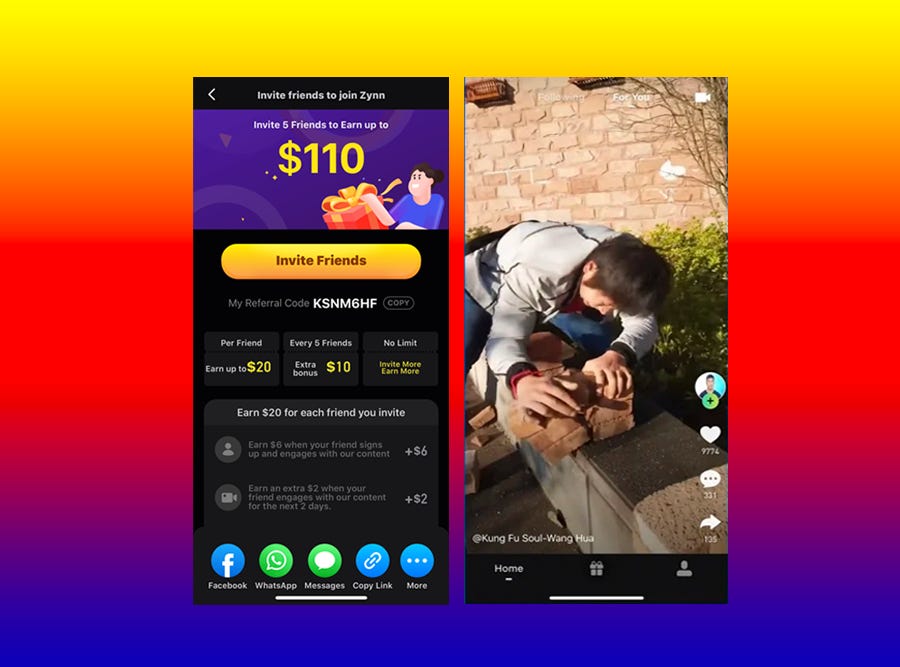What is Zynn? And who is its parent company Kuaishou?
The newest social short video app on the block dethroned TikTok from its longstanding first place in May 2020.

Unknown to most of us, Zynn quietly launched on the app store in early May. Fast forward to May 31st, Zynn has now claimed the number one spot in entertainment on the US iOS app store, according to App Annie. A nearly shot-for-shot (no pun intended) remake of ByteDance’s TikTok, Zynn joins a growing market of hyper-casual social apps targeted at millennials and Gen Z.
Zynn users, similar to TikTok, can view, comment, like and share an endless stream of portrait videos created by other users. However, Zynn is paying its users to watch and refer friends onto the platform. Users can earn up to $110 for referring 5 others to register. The catch is that your referred users must engage with Zynn’s content for a minimum of 1 hour, to qualify for your payout. Additional cash bonuses are available if your referred users continue to engage past day 1. When I downloaded Zynn, I received $1 simply for signing up, without a referral.
A quick browse of Zynn’s website show that the app is made by Beijing company Owlii, a startup developing 3D reconstruction technology for AR and VR applications. According to The Information, Owlii was acquired by Kuaishou - which is where things get interesting.
Zynn may be merely a month old, but Kuaishou is a veteran key to pioneering the short-form video format we know of today. Kuaishou (快手) launched in 2014 in China, and was one of the first mobile applications to offer a easy video-making platform for consumers to create minute-long video content. Douyin, TikTok’s Chinese counterpart, wouldn’t be launched until 2 years later. Kuaishou, valued at $30 billion, currently boasts more than 300 million daily active users in China, and is the second largest short video app trailing Douyin in the country.
Outside of China, Kuaishou’s short video app is known as Kwai. Nonetheless, Zynn is the company’s first and official attempt at entering and capturing the massive US consumers market. TikTok’s recent booming success must have provided a signal of confidence in marking the US as a promising demographic that’s worth the investment from the heavily-funded Kuaishou.

Before I get into forecasting the TikTok vs. Zynn rivalry outcome, here’s a short intermission about an ancient short video app that blew up big, first, in the States. Does anyone remember Vine?
Vine launched in 2012 as a mobile app to create short looping video clips of 6 seconds or less. Popular Vine memes, that still very much exist in popular culture today, include “Why You Always Lyin,” “Damn Daniel,” and “What are those?” It didn’t take long for Vine’s strong community following to catch the attention of Twitter execs, who acquired the company in October 2012 for a reported $30 million. By January 2017, however, Vine was shut down by Twitter. Finally in January 2020, Vine co-founder Dom Hofmann unveiled Byte, the new successor to Vine exactly 3 years later. Byte’s differentiation factor is its emphasis on helping content creators, or influencers monetize. Byte is establishing a partner program on the platform with offerings such as revenue sharing. Byte was well-received in its first week, touting over a million downloads on iOS and Android, earning them the top spot in entertainment, according to App Annie. But its nostalgia factor could not hold up against the mass following and influence TikTok has already built up in Vine’s long absence (and lack of competitors) in the US short video market. By May 24th, Byte dropped to #291 on the app store, according to data from App Annie.
I also opened a Byte account myself when they first launched, out of curiosity and to compare the difference with TikTok, which is minuscule, once again. Could Byte revive itself and become a formidable competitor in the short video market once again? In Chinese, there is the saying called 坐享渔人之利, to describe how a third party, sitting idle, enjoys gains and benefits reaped at the expense of the competing or involved bodies. While the world is fixated on pitting Zynn agaginst TikTok, Byte is one I will be watching closely as competition in casual short videos ramp up.
Now onto the main stage battle between Zynn and TikTok. Firstly, the fact that both video apps are made and backed by Chinese companies, and are making names for itself in the US, is causing concern for many. Besides the fact that the United States is the most patriotic country based on the 2020 YouGov survey, its President has long slammed Beijing for its handling of technology - accusing the PRC of stealing private data and intellectual property. Recently, TikTok was put on blast for its alleged censorship of the #BlackLivesMatter movement and for its removal of videos addressing the George Floyd situation. As we know, Chinese netizens are contained within strict Firewall rules, and Douyin is meticulously vetted by the government for its content. With Trump’s accusation of TikTok committing acts such as data harvesting combined with the platform’s users’ growing frustration on being muted, Zynn could stand as an easy alternative. That said, Zynn is similarly created by a Chinese company, and the same issues and public concerns may arise as the app swells in size.
In China, Kuaishou differentiates from its ominous competitor Douyin, by targeting the outskirt communities in rural China. Douyin, on the other hand, predominantly lives in tier-1 city centres. Two exact same apps, surviving (or thriving in most cases), for providing identical product offerings. This is possible given the country’s whopping 904 million internet population, according to Statista. Meanwhile, the US’s 275 million internet users seem comparatively small. China’s gigantic internet population is one of the main reasons why the country has a handful of replica-apps across various industries.
For example, ByteDance’s Jinri Toutiao (今日头条) competes fiercely with the Tencent and Alibaba-backed Qutoutiao (趣头条) in the news aggregator space. Both apps provide personalized feeds and recommended reads for users, with Qutoutiao targeting lower-tier cities. Kuaishou launched Kuaikandian (快看点) in 2019 as their attempt to penetrate the news aggregator market to little avail.
Although you can stream directly on both Douyin and Kuaishou, streaming-specific applications have discovered a demand from Chinese live-streaming avids (called 主播, which fittingly translates to live host). Popular live-streaming platforms include YY with 157 monthly active users in 2019, and Momo with 114.5 million monthly active users in 2019, according to Statista.
It makes sense why so many apps that are clones of one another pop up in China. Accessing and capturing merely 30% of the market would be equivalent to conquering the entire internet population in the US. It also weakens the potential for market monopolies when there are so many small and local players scattered across every domain.
Now let’s compare this to key entertainment players in the US. Social media such as Twitter, Snapchat, and Facebook’s Instagram are created with different purposes at its core. Its interface and design are noticeably different, besides a couple of “inspired” features here and there (ahem, stories). Netflix is the leading video streaming platform for now, but notable competitors are rapidly eating into its market share. Nonetheless, these streaming networks, for the most part, offer exclusive content that’s solely originals available nowhere else. On the contrary, the top video streaming platforms in China are Tencent Video and iQIYI (爱奇艺), who both surpassed the 100 million paying subscribers mark early this year. Having been a subscriber of both services for 3 years and counting, I can say that the content from both services largely overlap each other, as much as their designs do.

Of course, the US internet demographic monetizes differently, and at a higher rate, than China’s internet demographic. But those factors are for another day’s story.
The entrance of Zynn poses the question - can the US short video market sustain two or more of the same social media platform, considering Byte? Will they eventually pivot to differentiate and find their individual niche or will one viciously outcompete the other? Is there even enough demand for short video entertainment in the long-run, or is it simply a COVID-fueled fad (as I analyzed in this piece)?
Another possibility is the consolidation of forces in the short video space. Smaller players like Byte may get bought out in the near future if they can’t independently persist. Potential bidders are likely aging digital companies that are losing its grip on reaching younger audiences (VICE), or tech companies seeking a head start to venture into this unique consumer video space (Twitch). Tech titan Facebook, a model in the industry for its cloning ability, may also look stimulate its lowkey Lasso app, which the company launched in 2018 to compete with TikTok.
All in all, Zynn’s recent entrance underlines Kuaishou’s ambition and hunger to dominate beyond its local market, as well as its well-prepared hefty bank account. Either way, we are in for an exciting battle between two of the most innovative and creative tech companies hailing from the world's second largest economy. And snapshots will unquestionably present you with the front row seat to all the action. Sit tight.


